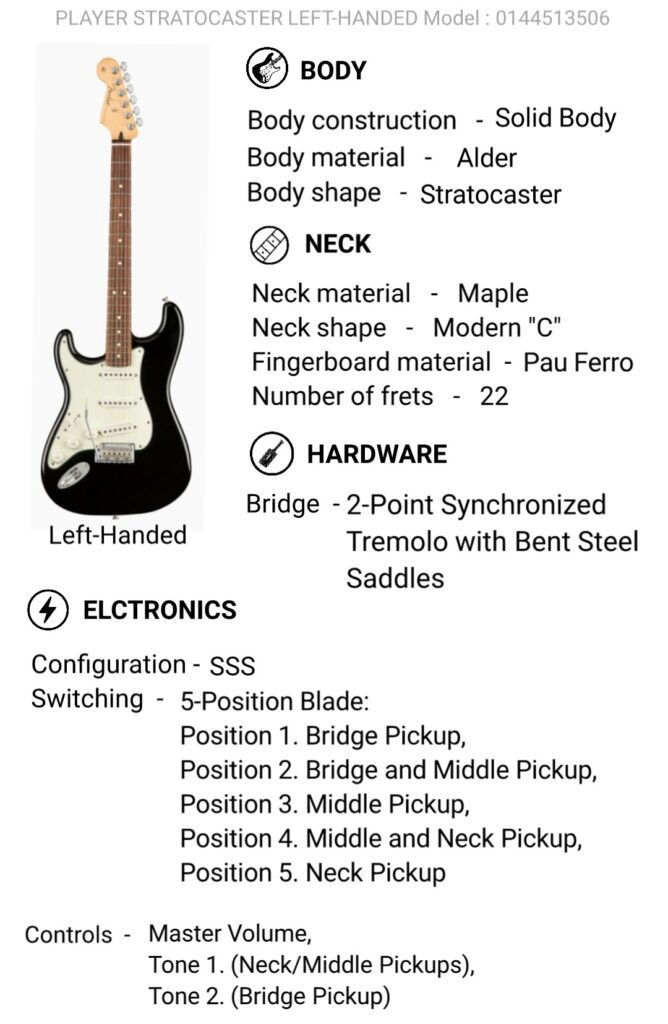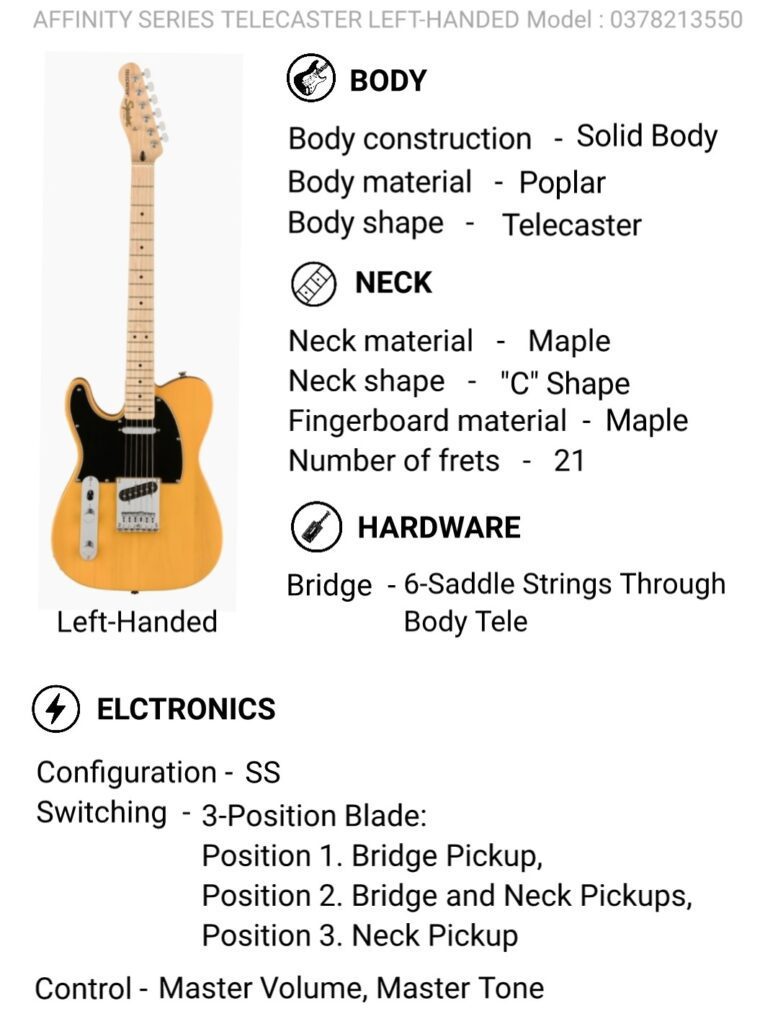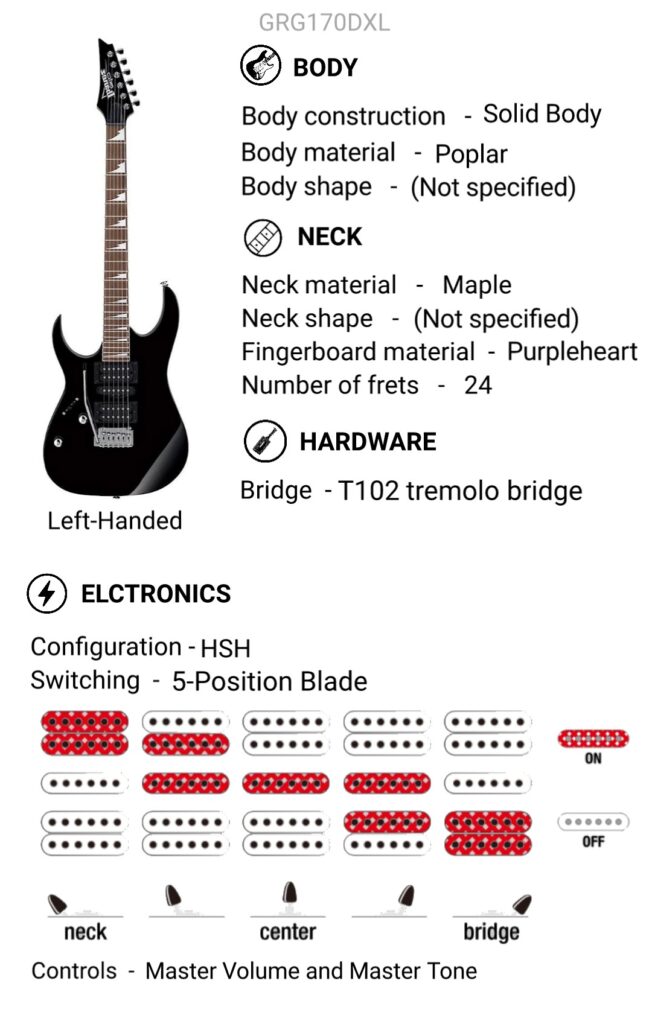List of Best Left-Handed electric guitar with Features specifications, You can compare electric guitar prices on different online stores.
Fender Player Stratocaster Left-Handed

Fender Affinity Series Telecaster Left-Handed

Introduction: Left-handed electric guitars are essentially mirror images of their right-handed counterparts, with the orientation of the neck, strings, pickups, and controls reversed to accommodate left-handed players. These guitars allow left-handed musicians to strum, fret, and perform techniques with their dominant hand, providing a more intuitive playing experience.
”Read_More”
Considerations for Left-Handed Players
- Availability: Left-handed electric guitars may have limited availability compared to right-handed models. Left-handed players might need to explore specialized music stores or online retailers to find suitable options.
- Price: Left-handed electric guitars sometimes come at a slightly higher price point due to lower demand and production costs associated with manufacturing left-handed versions of instruments.
- Testing and Trying: Left-handed guitarists are encouraged to test out various models to find the one that feels most comfortable and suits their playing style and preferences.
- Customization: Some left-handed players opt for custom-built guitars to tailor the instrument precisely to their specifications, including choice of tonewoods, pickups, hardware, and finishes.
Conclusion
Left-handed electric guitars play a crucial role in ensuring that left-handed musicians can fully express themselves musically. With a range of models, pickup configurations, and features available, left-handed players have more options than ever to find the perfect instrument for their needs. Whether they’re shredding solos, strumming chords, or laying down funky grooves, left-handed electric guitars empower southpaw guitarists to make their mark in the world of music.
How to choose Best Left Handed electric Guitar
Choosing the best left-handed electric guitar involves considering several factors to ensure it meets your needs and preferences. Here’s a guide to help you make the right choice:
- Playability: Opt for a guitar with a comfortable neck profile and fretboard radius that feels natural in your hand. Test out different neck shapes (e.g., C-shaped, D-shaped) to find one that suits your playing style.
- Pickup Configuration: Consider the type of sound you want. Single-coil pickups offer bright, articulate tones ideal for genres like blues, rock, and country. Humbuckers provide thicker, warmer tones suited for heavier styles like hard rock and metal. Some guitars feature a combination of both for versatility.
- Build Quality: Look for a guitar made from high-quality materials that ensure durability and resonance. Solid wood bodies and necks typically offer better sustain and tone compared to laminates.
- Comfort and Ergonomics: Pay attention to the guitar’s body shape and weight. Choose a design that feels comfortable against your body, especially during long practice sessions or performances. Ergonomic features like contoured bodies and sculpted heel joints can enhance playing comfort.
- Hardware and Electronics: Evaluate the quality of the hardware components such as tuners, bridge, and controls. Ensure they are well-made and provide smooth operation. Additionally, consider features like coil-splitting, active/passive switching, and tone-shaping controls for added versatility.
- Brand Reputation: Research the reputation of guitar brands known for producing high-quality left-handed models. Look for feedback from other left-handed players and consider brands with a history of catering to southpaw guitarists.
- Budget: Set a budget based on your financial constraints and requirements. While premium guitars offer top-notch craftsmanship and features, there are also excellent options available at more affordable price points.
- Try Before You Buy: Whenever possible, try out different guitars to assess their feel, sound, and playability. Visit guitar stores to test various models and get a sense of what suits you best.
- Online Reviews and Recommendations: Read reviews from other left-handed players and seek recommendations from forums or social media groups dedicated to guitar enthusiasts. These resources can provide valuable insights into specific guitar models and brands.
- Warranty and Support: Check the warranty coverage and customer support offered by the manufacturer or retailer. A solid warranty ensures peace of mind and protection against potential defects or issues.
By considering these factors and conducting thorough research, you can select the best left-handed electric guitar that meets your requirements and inspires your musical journey.
Why Left Handed electric Guitars are More Expensive ?
Left-handed electric guitars are often more expensive than their right-handed counterparts due to several factors:
- Lower Demand: Left-handed guitars represent a smaller market share compared to right-handed guitars. Manufacturers produce fewer left-handed models, leading to economies of scale that result in higher production costs per unit. This lower demand can drive up prices as manufacturers need to recoup their costs over a smaller number of units sold.
- Specialized Production: Producing left-handed guitars requires retooling and specialized processes, especially for components like the nut, bridge, and controls. This additional manufacturing complexity can contribute to higher production costs, which are passed on to consumers in the form of higher prices.
- Limited Selection: Left-handed guitarists often have a limited selection of instruments to choose from, especially in brick-and-mortar stores where retailers may stock fewer left-handed models due to lower demand. This limited availability can lead to higher prices as left-handed players may be willing to pay a premium for a guitar that meets their needs.
- Custom Orders: Some left-handed players opt to custom order guitars to get exactly what they want. Custom orders typically come with higher price tags due to the personalized nature of the instrument and the additional time and labor involved in crafting it to the customer’s specifications.
- Import Costs: Left-handed guitars may incur higher import costs, especially if they are manufactured in countries where left-handed models are less common. Importing left-handed guitars from overseas can involve additional expenses such as tariffs, shipping, and customs fees, all of which contribute to higher retail prices.
- Limited Resale Value: Left-handed guitars generally have lower resale value compared to right-handed guitars due to their niche market. As a result, manufacturers may factor in the potential for slower inventory turnover and increased holding costs when pricing left-handed models, further contributing to higher retail prices.
Overall, the combination of lower demand, specialized production processes, limited selection, custom orders, import costs, and limited resale value collectively contribute to the higher prices often associated with left-handed electric guitars.
History of Left Handed electric Guitars
The history of left-handed electric guitars mirrors the broader evolution of electric guitars themselves, albeit with some unique challenges and considerations due to their specialized nature. Here’s a brief overview of the history of left-handed electric guitars:
- Early Years: In the early days of electric guitars, which saw significant developments in the 1930s and 1940s, left-handed options were virtually non-existent. Manufacturers primarily focused on right-handed models due to the larger market demand and logistical simplicity.
- Emergence of Left-Handed Models: As the popularity of electric guitars grew in the mid-20th century, particularly with the rise of rock and roll in the 1950s and 1960s, manufacturers began to offer left-handed versions of their instruments. However, left-handed models were often limited in availability and variety compared to their right-handed counterparts.
- Struggle for Recognition: Left-handed guitarists faced challenges in accessing suitable instruments, as many stores carried minimal or no inventory of left-handed guitars. This forced many left-handed players to adapt to right-handed guitars or seek out specialized dealers or custom builders willing to cater to their needs.
- Custom Orders and Modifications: Left-handed players often resorted to custom orders or modifications to obtain suitable instruments. Some guitarists would reverse right-handed guitars, restringing them and reversing the nut and bridge to convert them into left-handed configurations. Others commissioned custom builds from luthiers willing to accommodate their preferences.
- Increasing Availability: Over time, the availability of left-handed electric guitars gradually improved as manufacturers recognized the demand from left-handed players. Major guitar companies began offering more left-handed options across their product lines, albeit still with a narrower selection compared to right-handed models.
- Diverse Offerings: Today, left-handed guitarists have a more diverse range of options to choose from, with many manufacturers offering dedicated left-handed models in various styles, price points, and configurations. Left-handed guitars are available in classic designs like the Stratocaster and Les Paul, as well as modern and custom instruments.
- Specialized Models and Signature Series: Some manufacturers produce specialized left-handed models or signature series guitars designed in collaboration with left-handed artists. These instruments cater to the unique preferences and playing styles of left-handed players, offering features tailored to their needs.
- Online Marketplaces and Communities: The rise of online marketplaces and communities has further facilitated access to left-handed guitars, allowing players to browse and purchase instruments from around the world. Left-handed players can now connect with like-minded individuals and access a wider range of options than ever before.
Despite historical challenges, the availability and recognition of left-handed electric guitars have significantly improved over the years, providing left-handed players with greater access to instruments that meet their needs and preferences.
”Read_Less”

